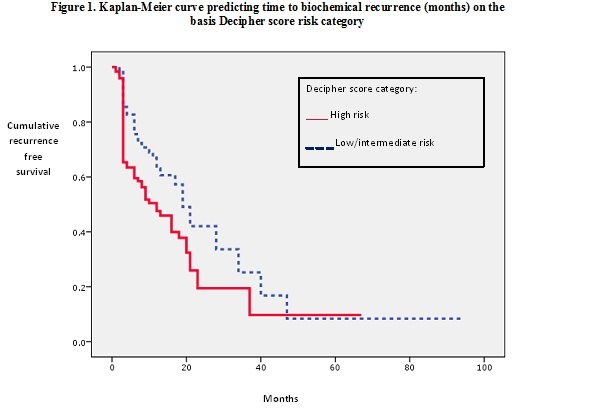Does Post Prostatectomy Decipher Score Predict PSA Recurrence and Impact Care?
Christine White, MD, Ilene Staff, PhD, Tara McLaughlin, PhD, Joseph Tortora, MS, Kevin Pinto, BS, Akshay Gangakhedkar, BS, Alison Champagne, MPH, Joseph Wagner, MD; Adnan Dervishi, MD
Hartford Hospital, Hartford, CT
BACKGROUND Decipher score (GenomeDx Biosciences) is a genomic classifier that predicts the 5-year risk of metastasis after radical prostatectomy (RP). Decipher score may also be used to guide the timing of adjuvant vs. salvage radiotherapy. We examined the ability of Decipher to predict biochemical recurrence (BCR) and to impact clinical decision making. METHODS We identified post-RP Decipher tests ordered for adverse pathology between 1/1/14 and 8/31/18. BCR was defined as a PSA>0.02 ng/mL. Decipher score was analyzed as both a continuous and categorical variable (high ≥.60, low/intermediate < .60). Kaplan-Meier analysis was used to examine the relationship between Decipher score and time to BCR (in months). Multivariate analysis with Cox Regression analyzed the relationships between Decipher score, pre-op PSA, pathologic Gleason, margin status and stage. We then focused on a subset of men with early BCR (eBCR; PSA >.02 and <.20 ng/mL) and categorized them into low/intermediate- vs. high-risk Decipher score. Logistic regression was used to determine if those with high scores were more likely to get salvage treatment. RESULTS A total of 208 patients underwent RP for prostate cancer with subsequent Decipher testing during the study period; 10 had no PSA follow-up. Of the 198 analyzed, 62%, 38%had high and low/intermediate risk Decipher scores, respectively and 51% had a BCR. The sample was characterized by unfavorable pathology. Over half (58.6%) had Gleason Grade Group 4+3 or higher and most (70.7%) had stage 3 disease or higher. Median (IQR) follow-up was 12.0 (6.6, 18.8) months. Decipher score was significantly associated with time to BCR (p = .02; Figure 1) but was not an independent predictor in multivariate analysis (p=.282). Among the 67 men with eBCR, those with high-risk Decipher scores were more likely to receive salvage treatment (59.5%) than those with non high-risk scores (20%; p = .001). This relationship was significant independent of pre-operative PSA, Gleason Grade Group, margin status and stage (OR = 4.20, p = .03). CONCLUSIONS High decipher score is a significant predictor of BCR in this population of men with unfavorable pathology and is being incorporated into patient counseling to inform early treatment decisions. Further research should focus on long-term outcomes for patients for whom Decipher score was used to guide treatment strategy vs. those for whom it wasn’t.

Back to 2019 Abstracts
